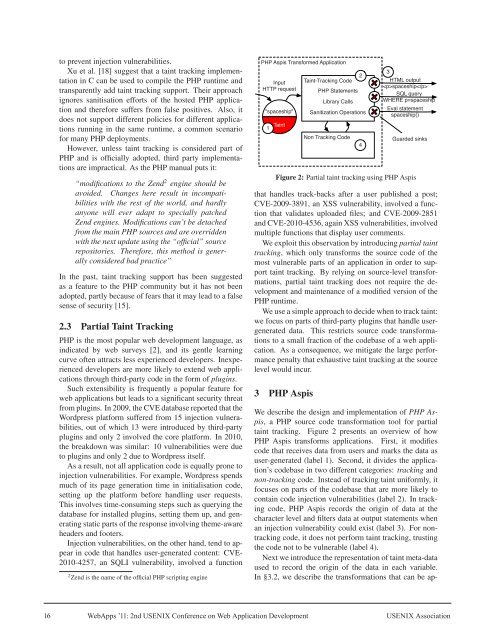2nd USENIX Conference on Web Application Development ...
2nd USENIX Conference on Web Application Development ...
2nd USENIX Conference on Web Application Development ...
You also want an ePaper? Increase the reach of your titles
YUMPU automatically turns print PDFs into web optimized ePapers that Google loves.
to prevent injecti<strong>on</strong> vulnerabilities.<br />
Xu et al. [18] suggest that a taint tracking implementati<strong>on</strong><br />
in C can be used to compile the PHP runtime and<br />
transparently add taint tracking support. Their approach<br />
ignores sanitisati<strong>on</strong> efforts of the hosted PHP applicati<strong>on</strong><br />
and therefore suffers from false positives. Also, it<br />
does not support different policies for different applicati<strong>on</strong>s<br />
running in the same runtime, a comm<strong>on</strong> scenario<br />
for many PHP deployments.<br />
However, unless taint tracking is c<strong>on</strong>sidered part of<br />
PHP and is officially adopted, third party implementati<strong>on</strong>s<br />
are impractical. As the PHP manual puts it:<br />
“modificati<strong>on</strong>s to the Zend 2 engine should be<br />
avoided. Changes here result in incompatibilities<br />
with the rest of the world, and hardly<br />
any<strong>on</strong>e will ever adapt to specially patched<br />
Zend engines. Modificati<strong>on</strong>s can’t be detached<br />
from the main PHP sources and are overridden<br />
with the next update using the “official” source<br />
repositories. Therefore, this method is generally<br />
c<strong>on</strong>sidered bad practice”<br />
In the past, taint tracking support has been suggested<br />
as a feature to the PHP community but it has not been<br />
adopted, partly because of fears that it may lead to a false<br />
sense of security [15].<br />
2.3 Partial Taint Tracking<br />
PHP is the most popular web development language, as<br />
indicated by web surveys [2], and its gentle learning<br />
curve often attracts less experienced developers. Inexperienced<br />
developers are more likely to extend web applicati<strong>on</strong>s<br />
through third-party code in the form of plugins.<br />
Such extensibility is frequently a popular feature for<br />
web applicati<strong>on</strong>s but leads to a significant security threat<br />
from plugins. In 2009, the CVE database reported that the<br />
Wordpress platform suffered from 15 injecti<strong>on</strong> vulnerabilities,<br />
out of which 13 were introduced by third-party<br />
plugins and <strong>on</strong>ly 2 involved the core platform. In 2010,<br />
the breakdown was similar: 10 vulnerabilities were due<br />
to plugins and <strong>on</strong>ly 2 due to Wordpress itself.<br />
As a result, not all applicati<strong>on</strong> code is equally pr<strong>on</strong>e to<br />
injecti<strong>on</strong> vulnerabilities. For example, Wordpress spends<br />
much of its page generati<strong>on</strong> time in initialisati<strong>on</strong> code,<br />
setting up the platform before handling user requests.<br />
This involves time-c<strong>on</strong>suming steps such as querying the<br />
database for installed plugins, setting them up, and generating<br />
static parts of the resp<strong>on</strong>se involving theme-aware<br />
headers and footers.<br />
Injecti<strong>on</strong> vulnerabilities, <strong>on</strong> the other hand, tend to appear<br />
in code that handles user-generated c<strong>on</strong>tent: CVE-<br />
2010-4257, an SQLI vulnerability, involved a functi<strong>on</strong><br />
2 Zend is the name of the official PHP scripting engine<br />
4<br />
PHP Aspis Transformed Applicati<strong>on</strong><br />
Input<br />
HTTP request<br />
"spaceship"<br />
Taint-Tracking Code<br />
N<strong>on</strong> Tracking Code<br />
16 <strong>Web</strong>Apps ’11: <str<strong>on</strong>g>2nd</str<strong>on</strong>g> <str<strong>on</strong>g>USENIX</str<strong>on</strong>g> <str<strong>on</strong>g>C<strong>on</strong>ference</str<strong>on</strong>g> <strong>on</strong> <strong>Web</strong> Applicati<strong>on</strong> <strong>Development</strong> <str<strong>on</strong>g>USENIX</str<strong>on</strong>g> Associati<strong>on</strong><br />
1<br />
Taint<br />
PHP Statements<br />
Library Calls<br />
2<br />
Sanitizati<strong>on</strong> Operati<strong>on</strong>s<br />
4<br />
3<br />
HTML output<br />
spaceship<br />
SQL query<br />
WHERE p=spaceship<br />
Eval statement<br />
spaceship()<br />
Guarded sinks<br />
Figure 2: Partial taint tracking using PHP Aspis<br />
that handles track-backs after a user published a post;<br />
CVE-2009-3891, an XSS vulnerability, involved a functi<strong>on</strong><br />
that validates uploaded files; and CVE-2009-2851<br />
and CVE-2010-4536, again XSS vulnerabilities, involved<br />
multiple functi<strong>on</strong>s that display user comments.<br />
We exploit this observati<strong>on</strong> by introducing partial taint<br />
tracking, which <strong>on</strong>ly transforms the source code of the<br />
most vulnerable parts of an applicati<strong>on</strong> in order to support<br />
taint tracking. By relying <strong>on</strong> source-level transformati<strong>on</strong>s,<br />
partial taint tracking does not require the development<br />
and maintenance of a modified versi<strong>on</strong> of the<br />
PHP runtime.<br />
We use a simple approach to decide when to track taint:<br />
we focus <strong>on</strong> parts of third-party plugins that handle usergenerated<br />
data. This restricts source code transformati<strong>on</strong>s<br />
to a small fracti<strong>on</strong> of the codebase of a web applicati<strong>on</strong>.<br />
As a c<strong>on</strong>sequence, we mitigate the large performance<br />
penalty that exhaustive taint tracking at the source<br />
level would incur.<br />
3 PHP Aspis<br />
We describe the design and implementati<strong>on</strong> of PHP Aspis,<br />
a PHP source code transformati<strong>on</strong> tool for partial<br />
taint tracking. Figure 2 presents an overview of how<br />
PHP Aspis transforms applicati<strong>on</strong>s. First, it modifies<br />
code that receives data from users and marks the data as<br />
user-generated (label 1). Sec<strong>on</strong>d, it divides the applicati<strong>on</strong>’s<br />
codebase in two different categories: tracking and<br />
n<strong>on</strong>-tracking code. Instead of tracking taint uniformly, it<br />
focuses <strong>on</strong> parts of the codebase that are more likely to<br />
c<strong>on</strong>tain code injecti<strong>on</strong> vulnerabilities (label 2). In tracking<br />
code, PHP Aspis records the origin of data at the<br />
character level and filters data at output statements when<br />
an injecti<strong>on</strong> vulnerability could exist (label 3). For n<strong>on</strong>tracking<br />
code, it does not perform taint tracking, trusting<br />
the code not to be vulnerable (label 4).<br />
Next we introduce the representati<strong>on</strong> of taint meta-data<br />
used to record the origin of the data in each variable.<br />
In §3.2, we describe the transformati<strong>on</strong>s that can be ap-








